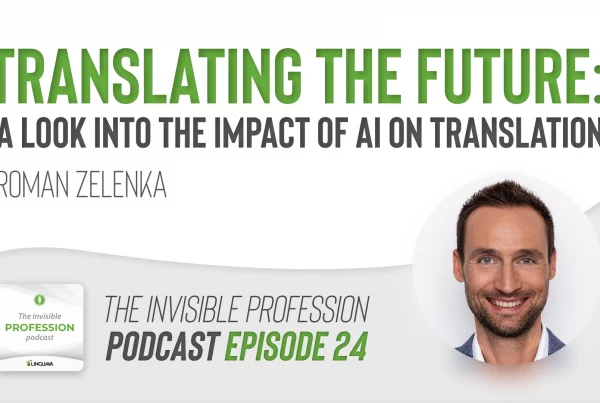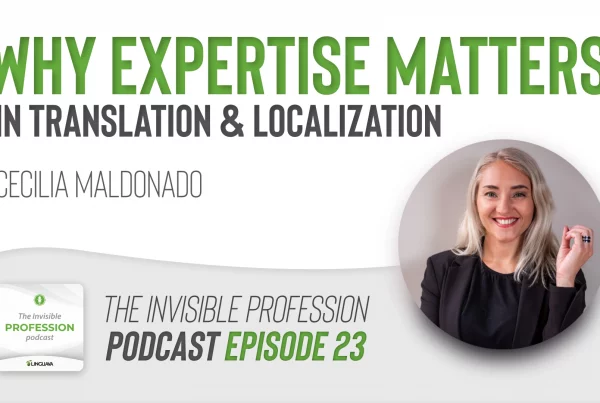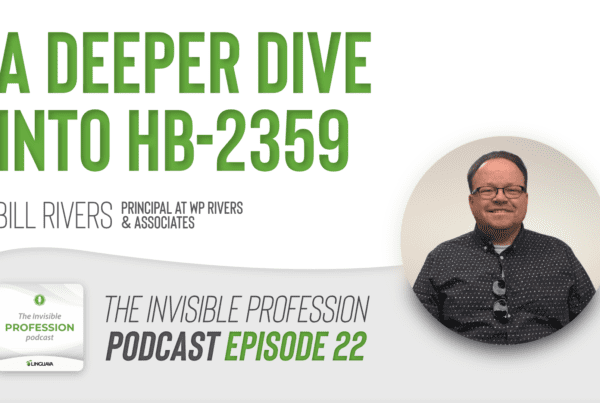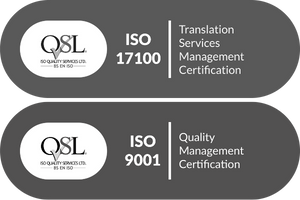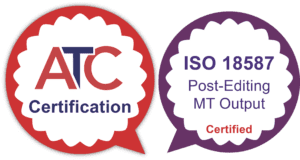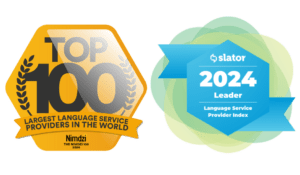In this episode of “The Invisible Profession” we explore how a language access toolkit can impact a patient’s experience through proactive preparation. Elizabeth Sanchez, the language access coordinator for Deschutes County Health Services, shares the language resources that her organization offers to its community members.
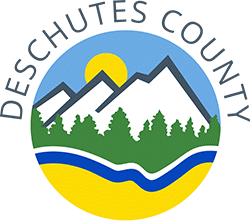 We discuss how their “language access auxiliary kit” was created, how it has been received, and other ways they engage with limited English proficient residents of their region.
We discuss how their “language access auxiliary kit” was created, how it has been received, and other ways they engage with limited English proficient residents of their region.
Make sure to follow Elizabeth here:
Deschutes Co Health Services FB
Deschutes Co Health Services FB – Spanish
Listen to our podcast on all your favorite platforms here.
Connect with us on your favorite social site:
LinkedIn | Facebook | Instagram
At Linguava, we are dedicated to reducing communication barriers and providing equity to all members of our community through language access services.
If you are interested in learning more about language access auxiliary kits, incorporating language access into your business, or would like to book a training session, contact us today.
Transcript – The Invisible Profession Podcast Ep. 019
Daniel: [00:00:00] Alright welcome to The Invisible Profession, Linguava’s podcast, exploring how we can go about utilizing language services in a responsive way to improve patient experience and health outcomes. This week is even more topical than others because the week of April 25th, through the 29th nationally, we celebrate Patient Experience Week, as a way of annually recognizing healthcare staff that impact the patient experience every day. This was brought about by the Beryl Institute’s community who really wants to allow organizations to highlight accomplishments and re-energize efforts and honor the teams that impact patient care in a positive way.
With that said, I don’t think there’s any way that we can view an impact on patient experience without exploring how language access comes into play. And so we’re luckily able to be joined today by a tremendous advocate for language access Elizabeth Sanchez, who I’d like to introduce to all of you coming to us from Deschutes county here in Oregon.
And I’d like [00:01:00] to say, hello and welcome. Thank you for being with us today, Elizabeth.
Elizabeth: Thank you. Thank you for the invitation. I’m happy to be here.
Daniel: We’ve got a lot of topics we’re going to be talking about today, but I’d love to, before we get into it, learn a little bit more, who you are, what your role is within the organization that you’re working with and what organization that is.
Elizabeth: Sure. My name is Elizabeth Sanchez, as you mentioned, my pronouns are she/her/ella. I work for Deschutes County, which a lot of your listeners are probably gonna wonder where Deschutes county is? So we are in the Bend area, Central Oregon. We’re one of the counties located in the central Oregon area. And my role is a language access coordinator. My role has been in place for two years and we started from scratch and I am a Latina that was raised between Mexico and here in Oregon.
Daniel: Thank you so much for that. And your role within that organization is the language access [00:02:00] coordinator, but you yourself are also a certified medical interpreter, correct?
Elizabeth: That is correct. Yes. I’ve been a certified medical interpreter for probably six, seven years.
Daniel: It’s so wonderful seeing the different ways that our medical interpreter community can look to career paths and see ways that they can expand their reach and really impact structures and systems in the way Deschutes county is lucky to have you doing those services for their community so that’s really wonderful.
Our topic today, we’re going to be talking about something that I got to see firsthand when I was out in bend visiting with you about a month and a half, two months ago. But I was really amazed to see something that you’re utilizing within your team. Can you tell us a little bit about language access auxiliary kits as you call it?
Elizabeth: Sure yes. So this is something that we implemented during the COVID mass vaccine clinic. We had this kind of in our plans, but we really were not putting it as a priority. But the need really arises during the mass vaccine clinics and these kits have been [00:03:00] so useful, we’ve gotten so much feedback in regards of how it has helped so many clients or patients throughout Deschutes county.
So these Auxiliary kits. And I’m going to show you a little bit what they are or what is part of the auxiliary kits. So I’m going to start with this device here. It is a pocket talker. So this is for community members that are Hard of Hearing. We are able to provide that, it comes with the headphones and then the covers.
So we’re able to provide this for our community that is hard of hearing. They could place it and there’s no need to put the microphone next to their mouth. It amplifies the sound. So it does an excellent job. We also have iPads, which is for our video remote interpreting, this has been very helpful for our mass vaccine clinic for our on demand [00:04:00] needs.
When somebody walks through the door that needs interpretation services, especially for American Sign Language, where we need something visual rather than over the phone, we can pull the iPad. Another thing to actually identify the language. We have Point to Your Language. So this is provided by Linguava. It tells us which language they speak. And from there we can get either over the phone services or the video remote interpreting. And so our staff would utilize the Point to Your Language, identify that language there, get the iPad that I just showed or call over the phone I have, and I’m going to cover this.
I have here the instructions on how to get somebody over the phone. An interpreter over the phone. If for again, Linguava has over 200 languages. So there are. It is probably gonna be an [00:05:00] available language if we call. Another thing that we have is it could be a white board, or it could be a notepad for anybody that comes in they are either Hard of Hearing, or they are Deaf, what we can do is communicate through the marker and either the whiteboard or a notepad and just give them simple instructions like “We are working to get an interpreter”. We do not have a full session, or a visit through the white board, as we are aware that English is their second language.
So we want to just give them instructions. We’re working on it. Give us a couple of minutes. We’ll get an interpreter so we can serve you. Like we should with an interpreter.
Daniel: Those are some really awesome pieces. Yeah. Continue. I’m sorry, go ahead.
Elizabeth: You’re fine. We also have, and I have all my devices around, so I’m just trying to find we have a magnifying glass.[00:06:00]
So this one actually comes with light. It has a white light that really helps. And these are for our community that has any impairment that has trouble seeing that forgot their glasses, things that are pretty simple and they want to fill out their documents, they want to read them for themselves, they have the ability to do it, and we’re just going to provide them the tools. As staff we have the obligation and the option to help them if that’s what they prefer for us to read the documents for them, but we also want to honor their decision if they want to fill it out themselves, then here’s the tool.
Go ahead and do let us know if there’s anything else we can do. So those are the things we have in our language auxiliary kits. And it is very tailored to the needs we have seen in our community.
Daniel: And I really want to highlight again, the way that language access is so expansive and beyond those language interpretation needs, you’re really coming into focus on the other aspects of [00:07:00] language access, including visibility.
When you’re talking about that magnifying glass that you have there, what a wonderful resource that maybe not all of our community organizations are thinking about for those points of encounter. And with that in mind, I’m actually curious. Where do you locate these language access toolkits within the different buildings or facilities that your organization has?
Elizabeth: Sure. So we have one language access kit in each building and the team that is in charge of them is our front office. So those front row facing staff is who has them at their reach for when the need arises. So in each location we have one again or locations that are large. And we do have a larger location that have two, so it depends really, but one front office is the standard.
Daniel: That’s yeah, that makes a lot of sense as points of contact where you might have emergent situations or someone walking in so useful to be able to pull from that [00:08:00] resource kit, like an emergency management kit, where you’re able to just pull from those particular aspects, not knowing what sorts of encounters you might have.
So I think that’s a wonderful way of being prepared for different sorts of encounters with the public, and really want to salute your part in that. And just curious, where did this idea come from for a language access auxiliary kit? How did you go about creating the checklist of the materials that you’re providing in your own kits?
Elizabeth: Sure. So this idea really came from networking and connecting with other language access coordinators and managers around Oregon. So it was something that was existing. I was not the creator of this, so it was just gathering those ideas. Other organizations that are like hospitals or larger organizations do include other things like a bed shaker a baby crying sensor device, a doorbell.
So there are other things: for our iPad, we manually take it from one [00:09:00] place to the other. We do a lot of Behavioral health so that allows us we’re in one place in one office, but in hospitals, there are a lot of, there’s a lot of movement, they go to x-ray, they go to the hospital bed, they go to the restroom.
There’s just a lot of movement so there for that option you would have to have a stand for the iPad. But again, we don’t have that need, but that is an option for having, including that to the language access auxiliary kit.
Daniel: What I really like about what you’re saying here is multi folded, right? There’s one, the idea of networking with peers and really drawing from best practices, sharing amongst other communities and other organizations that maybe have different needs and tailoring your own language access auxiliary kit, so the needs of your community and the services that you provide.
So that’s really wonderful to hear. And I appreciate the way that you are exploring those different dynamics between maybe an inpatient setup, as opposed to outpatient behavioral services, like the ones you provide at your organization. [00:10:00] One thing that I’m also curious about is: over COVID, even right now, we’re not even in the same room, you and I, so we’re in different locations, there’s a lot of hybrid workspaces that are occurring, and so it’s great to have some of these resources that you’re pointing at. It’s great to have these physical objects and a language access toolkit, but are there any ways that your organization and you, and your role providing language access through that program go about providing digital resources to the service providers in your area?
Elizabeth: Yes, of course. And I think that because again, we’re behavior health, it has allowed us to do a lot of remote work. We can have sessions online too. That means that a lot of our clinicians are working from home. So there is a need. And even before COVID we had a lot of digital options for our clinicians, providers, staff.
And so one of the things that we do have is our internal intranet page. We do have a section for language access and [00:11:00] there are phone number, my direct phone number, the email that is the centralized email for any requests and any scheduling needs. We also have for on demand services. This card that I showed, we have it in a digital format with just a click and it takes you to that., which is an electronic card, so that helps them know who to call, what to expect. And so there’s every things that I showed you here information detailed information of when they could use it. And so there is a page also just workflow of an in our case, we’d worked with Epic. How do you document that you worked with an interpreter, so workflows, information, laws, house bills, there’s all sorts of information around language access.
Daniel: If I had a hat tip to you, I would, because that is just on point with regards to how we make this information available to our service providers, to really, again, impact patient experience and improve those outcomes as a result of [00:12:00] making sure that they have access to the information that they need to understand their care and the ways that you’re going about it are just so wonderful to hear. Coming back to in-person situations, speaking about the demographics of your region. Do you have a particular language, a particular needs that you find are higher represented within the community that you work with?
Elizabeth: Yes for us in Deschutes county, our language of higher diffusion after English would be Spanish, and then American Sign Language.
So those are the two that are our highest numbers. So around that we have made sure that there’s information translated available on our website. In all our documents that are public facing are translated to Spanish and we have the English option of course.
Daniel: That’s so wonderful to hear. And then in addition to that, as you yourself mentioned, in addition to being a Spanish interpreter and a Spanish speaker, there are other members of your organization that are Spanish speakers.
And is there any way that they’re [00:13:00] able to identify themselves to the community so that if a community member is looking for help, they’re wandering around, they’re trying to figure out who to talk to before they’ve encountered that language access toolkit. How can staff identify themselves as a resource to those community members?
Elizabeth: Of course. I think that’s a really important piece, and as a Latina, I see it a lot that we don’t have the courage to go and ask and try to get by with our English. If we don’t see somebody that speaks Spanish, we might not just ask the question. We’re probably going to walk away. So making sure that they know there is staff that speaks Spanish that is also part of their culture, allows them to feel trust and approach us and ask those questions that they want to ask. So we have found, and I’m going to show you here a little pin that says, and I have another one here that will get you a little closer “hablo español” which means I speak Spanish.
And that is any employee that speaks Spanish can have [00:14:00] one on their badge, their outfit. We also have these little signs that go on the window of like front office. The binder, if it’s a home visit, whatever the case may be we have that where it’s visible and folks can see it and feel comfortable. “Oh, you speak Spanish?”
Let me ask you in my language, I’ve been wanting to ask but I was too embarrassed or I wasn’t sure how to word in English. So then that is that connection and that trust where they could ask those questions and receive our services.
Daniel: That’s so wonderful. And again, I just really want to congratulate you and also the entire language access program that you’re running over there with Deschutes to be able to provide these services, really thinking holistically about the way that your patients and your clients are moving through the different systems, interacting with them, and it’s wonderful to see. But with all that said, I’m really curious I’d like to turn this to our community and ask you all. What are things that you would put in your language access [00:15:00] auxiliary kit? Are there things that you maybe have thought of that we haven’t mentioned today or shown in this demonstration with Elizabeth, we’d love to hear from you.
And again, as we heard from Elizabeth, this is something that she gained insight into by networking and talking with other communities and other organizations that are having similar practices. So we hope to stimulate that conversation and hear from all of you about what you’re currently doing within your language access toolkit, so that we can promote those best practices and really encourage all organizations in our region to promote patient experience.
So with that said, Elizabeth, I’d like to thank you again for joining us today for this conversation. It’s been wonderful to have you and learn from all the things you’re doing for Deschutes county.
Elizabeth: Thank you. Thanks for the invitation, and thank you for having me.
Daniel: It’s been my pleasure and thank you all for joining us for The Invisible Profession: Linguava’s podcast. Have a wonderful day.


